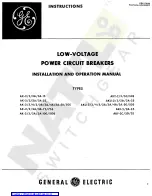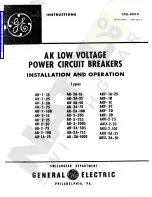
4.1.1 BOBINA DE ABERTURA
(Opcional)
Energizando a Bobina de Abertura (ST), via local
ou entrada remota, ativa instantaneamente o
mecanismo do disjuntor, garantindo uma rápida
operação de abertura.
Um contato auxiliar garante que o disparo foi
feito e que o disjuntor está aberto.
A Bobina de Abertura está disponível montada
de fábrica ou como unidade de fácil montagem
em campo com uma grande variedade de
tensões aplicáveis.
NOTA:
Este acessório é um dispositivo de bloqueio,
podendo ser utilizado para intertravamento de
disjuntores automáticos. O disjuntor não poderá
ser fechado por meios elétricos (nem manuais),
uma vez que a bobina de abertura esteja
energizada.
Instalação da Bobina de Abertura
1. Remova a face frontal como explicado.
2. Este acessório é montado na parte superior
do mecanismo, na 1ª ou 4ª localização como
mostrado na Fig. F.
3. A bobina avança e engata no gancho frontal
da placa de suporte no topo do mecanismo
como mostrado na Fig. B. Empurre o acessório
para o fundo até que o gancho traseiro engate
na abertura da placa de suporte do como
mostrado na Fig. C.
4. Após instalar a Bobina de Abertura na placa
de suporte no topo do mecanismo, ligue os fios
aos terminais secundários B11/B12 como
mostrado na Fig. D.
5. Garanta a firmeza da conexão e que está
ligada aos terminais corretos.
6. Ponha a face frontal como explicado.
4.1.1 SHUNT RELEASE
(Optional)
Energizing the shunt release (ST), via local or
remote input, will instantaneously activate the
circuit breaker mechanism, ensuring a rapid
open operation.
An auxiliary contact ensures that the release is
disconnected when the Circuit breaker is open.
Shunt Releases are available as a factory
mounted devices or as a easy to fit field
installable units in a wide range of voltages.
NOTE:
This accessory is a Voltage ON/No Close device
and can be used to interlock breakers. The
Circuit Breaker cannot be closed /electrically (or
Manually) as long as the release is energized.
Installation of Shunt Release
1. Remove the fascia as explained.
2. This accessory is mounted on the mechanism
top plate at 1st or 4th location as shown in Fig. F.
3. Tilt the coil forward and engage the front
hooks into the mechanism top support plate as
shown in the Fig. B. Tilt the device backwards
until the rear hooks engage in the slots on the
mechanism top support plate as shown in the
Fig. C.
4. After installing the shunt release on the
mechanism top plate, connect the input wire
assembly plug to the B11/B12 locations marked
on the secondary disconnect as shown in Fig. D.
5. Ensure that the plug in connection is firm and
that the plug is inserted into the correct
terminals.
6. Assemble the fascia as explained.
EntelliGuard L
ACCESSORIES
4
.1
C
OILS
4.1-03
Instruction sheet
Folha de Instruções
Instrukcja
4.1.1 WYZWALACZ NAPIĘCIOWY
(Opcjonalny)
Doprowadzenie napięcia do wyzwalacza
napięciowego (ST) poprzez wejście lokalne lub
zdalne natychmiastowo uruchamia mechanizm
wyłącznika, zapewniając błyskawiczne
otwieranie.
Styk pomocniczy powoduje odłączenie
wyzwalacza gdy wyłącznik jest otwarty.
Wyzwalacze napięciowe są dostępne jako
podzespoły montowane fabrycznie lub w
miejscu eksploatacji, są produkowane w
szerokim zakresie napięć.
UWAGA:
Wyzwalacz ten nie pozwala zamknąć
wyłącznika gdy jest zasilany napięciem i może
być używany do blokowania wyłączników.
Wyłącznik nie może być zamknięty (elektrycznie
lub ręcznie) gdy wyzwalacz jest zasilany
napięciem.
Instalac
ja wyzwalacza napięciowego
1. Zdjąć płytę czołową według wskazówek.
2. Wyzwalacz jest mocowany na
pionowej
ściance
mechanizmu w przedziale nr 1 lub 4 jak
pokazano na Fot. F.
3. Przechylić cewkę do przodu i zaczepić
zaczepy z przodu w pionowej ściance nośnej
mechanizmu jak pokazano na Fot. B. Przechylić
wyzwalacz do tyłu aby zaczepy z tyłu wsunęły
się w szczeliny pionowej ścianki mechanizmu w
sposób pokazany na Fot. C.
4. Po zainstalowaniu wyzwalacza napięciowego
w pionowej ściance mechanizmu należy
podłączyć wtyczkę przewodów do punktów
B11/B12
oznaczonych na listwach zaciskowych
jak pokazano na Fot. D.
5. Sprawdzić czy wtyk w złączu jest połączony i
czy wtyczka jest włożona do właściwych złączy.
6. Zamontować płytę czołową zgodnie ze
wskazówkami.
Shunt releases:
Voltage
Factory mounted
Field kit /Accessories
Bobina de Abertura:
Tensão
Montado em Fábrica Kit Vampo /Acessórios
Wyzwalacz Napięciowy
Napięcia sterujące
I
nstalacja fabryczna
Do montażu w miejscu instalacji
..
2
4V DC
GSTR024D
GSTR024DR
48V AC-DC
GSTR048
GSTR048R
110-130V AC-DC
GSTR120
GSTR120R
220-240V AC-DC
GSTR240
GSTR240R
380- 415V AC
GSTR400A
GSTR400AR
VDC = V c.c.
VAC = V c.a.
Removal of Front cover
1
. Remove pad locks, installed if any. Switch off the breaker.
2.
Unscrew the 4 screws (6Nm, 4.42ft-lbs) using a Pozidrive screw driver as shown in
Fig. A&B.
3.
Rotate the charging handle down and slide the front cover over the handle to
remove out as shown in Fig. C.
Remoção de Frontal / Cobertura Frontal do disjuntor
1.
Remova os cadeados, se instalados. DESLIGUE o disjuntor.
2.
Desaperte os 4 parafusos usando uma chave Pozidrive como mostrado na Fig. AeB.
3.
Rode para baixo a alavanca de carregamento e puxe a face frontal deslizando pela
alavanca para remover como mostrado na Fig. C
Usunięcie płyty czołowej
1.
Usunąć kłódki, jeśli są założone
. Wyłączyć wyłącznik.
2.
Odkręcić
4
śrub
(6Nm)
używając wkrętaka
Pozidrive w sposób pokazany na Fot. AiB.
3
.
Obrócić korbę w dół i przesunąć płytę czołową nad dźwignią aby zdjąć ją w sposób
pokazany na Fot.
C.
A
B
C
C








































